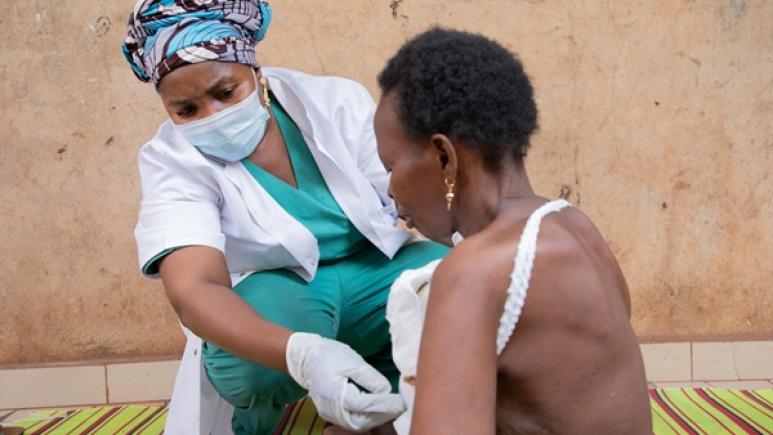Fighting breast cancer in Mali, a challenge that can be met
🟣Major challenges in the fight against breast cancer in Mali
- Extremely low 3-year breast cancer survival rate (12.69% vs. 52% in Ghana) according to a study conducted in 2015 (2)
- Very limited oncology care: five oncologists, four radiotherapists, and six pathologists for more than 22 million inhabitants (3, 4)
- Only one radiotherapy machine, which is often out of order.
- Restricted access to histochemical analyses and pathology laboratories.
- Diagnosis generally made at an advanced stage and many aggressive forms (triple-negative and high-grade tumors) (5, 6)
🟣 MSF France's actions to support breast cancer care in Mali since 2018
- Support for palliative care and early detection.
- Renovation of a pathology laboratory.
- Adaptation of protocols to available resources.
- Training of health personnel and awareness-raising among women.
🟣 A retrospective observational study of the cohort of women with breast cancer treated with MSF France support
Five years after the launch of the “Oncology Project,” MSF France's involvement also enabled Epicentre to conduct a retrospective observational study by examining the medical records of women with breast cancer treated with MSF France support. This is essential for analyzing their care pathway in detail, assessing survival based on various factors, identifying disparities or specific needs, and defining targeted actions to improve their care and quality of life.
🟣Key findings of the study
- Often late diagnosis: 77% of patients had advanced-stage (III-IV) breast cancer at the time of diagnosis
- Overall survival at 1, 2, and 3 years: 91%, 80%, and 72% respectively—among the highest rate in sub-Saharan Africa.
- Early diagnoses doubled between 2019 and 2022 (from 15% to 26.5%).
- 57% of patients did not undergo histological analysis; among those who did, 54.4% had triple-negative cancer, which is difficult to treat.
- The combination of chemotherapy and surgery was the most common treatment option (42.7%), followed by chemotherapy alone (39.3%).
- In patients diagnosed at an advanced stage, survival was significantly improved when several therapeutic modalities were combined—including chemotherapy, surgery, and, when possible, radiotherapy.
🟣 What this study shows
Multidisciplinary, personalized, and tailored cancer care is possible, even in low-resource settings.
Lessons to be learned
The study highlights several key levers for improving breast cancer care in Mali:
- Strengthen early diagnosis: by training healthcare personnel and raising awareness among women, in order to increase survival rates.
- Promote multidisciplinary care: combining several therapeutic modalities (chemotherapy, surgery, radiotherapy) significantly improves outcomes.
- Improve access to histochemical analyses: these are essential for tailoring treatments to patients' biological profiles.
- Develop radiotherapy services: currently limited to a single machine, which is often out of service.
Areas for further research
- Establishing longer-term follow-up: to better document patients' quality of life and refine treatment strategies.
- Evaluate available treatment combinations: to determine the most effective combinations in terms of survival, particularly in resource-limited settings.
- Understanding the genetic factors that could explain the high proportion of triple-negative cancers, which are particularly difficult to treat.
© Fatoumata Tioye COULIBALY
1- Ferlay J, Ervik M, Lam F, Laversanne M, Colombet M, Mery L, et al. Global Cancer Observatory: Cancer Today [Internet]. Lyon, France: International Agency for Research on Cancer; 2024. https://gco.iarc.who.int/media/globocan/factsheets/populations/466-mali-fact-sheet.pdf
2. Sidibe Y, Ly M, Kayentao K, Kamate B, Sissoko M. Survie des femmes souffrant de cancer du sein au Mali: analyse d'une cohorte de 124 cas pris en charge au Centre Hospitalo-Universitaire du Point G de janvier 2007 à octobre 2010. Rev Malienne Sci Technol [Internet]. 29 déc 2019 [cité 23 juill 2024];(22):66‑79. https://www.revues.ml/index.php/rmst/article/view/1415
3. Schantz C, Diarra I, Traoré A, Traoré BA, Chabrol F, Sogoba S. Radiothérapie et lutte contre les cancers : défis de maintenance de l’unique accélérateur linéaire à l’Hôpital du Mali. Santé Publique [Internet]. 2022 [cité 23 juill 2024];34(3):425‑8. Disponible sur: https://www.cairn.info/revue-sante-publique2022-3-page-425.htm
4. Cellule de planification et de statistique, secteur santé, développement social et promotion de la famille (CPS/SS-DS-PF). Annuaire statistique 2022 des hôpitaux [Internet]. Ministère de la Santé et du Développement Social; Disponible sur: https://files.aho.afro.who.int/afahobckpcontainer/production/files/Annuaire_SIH_2022.pdf
5. Huo D, Ikpatt F, Khramtsov A, Dangou JM, Nanda R, Dignam J, et al. Population differences in breast cancer: survey in indigenous African women reveals over-representation of triple-negative breast cancer. J Clin Oncol Off J Am Soc Clin Oncol. 20 sept 2009;27(27):4515‑21.
6. Ly M, Antoine M, Dembélé AK, Levy P, Rodenas A, Touré BA, et al. High Incidence of Triple-Negative Tumors in Sub-Saharan Africa: A Prospective Study of Breast Cancer Characteristics and Risk Factors in Malian Women Seen in a Bamako University Hospital. Oncology [Internet]. 4 sept 2012 [cité 20 juill 2024];83(5):257‑63. Disponible sur: https://doi.org/10.1159/000341541








